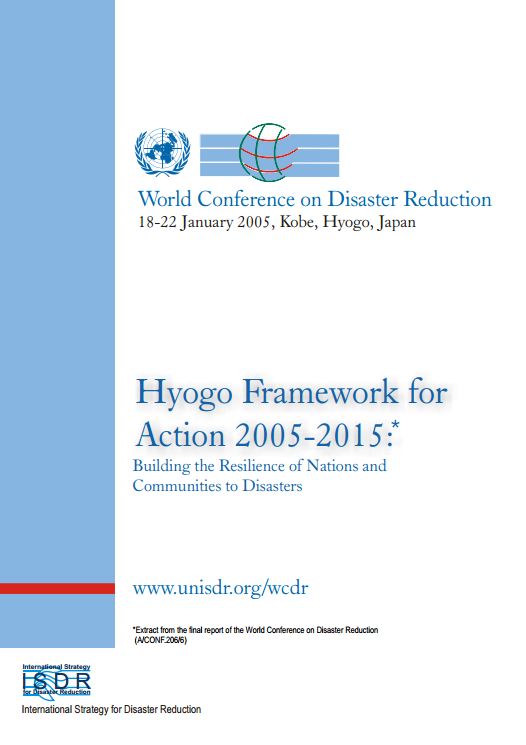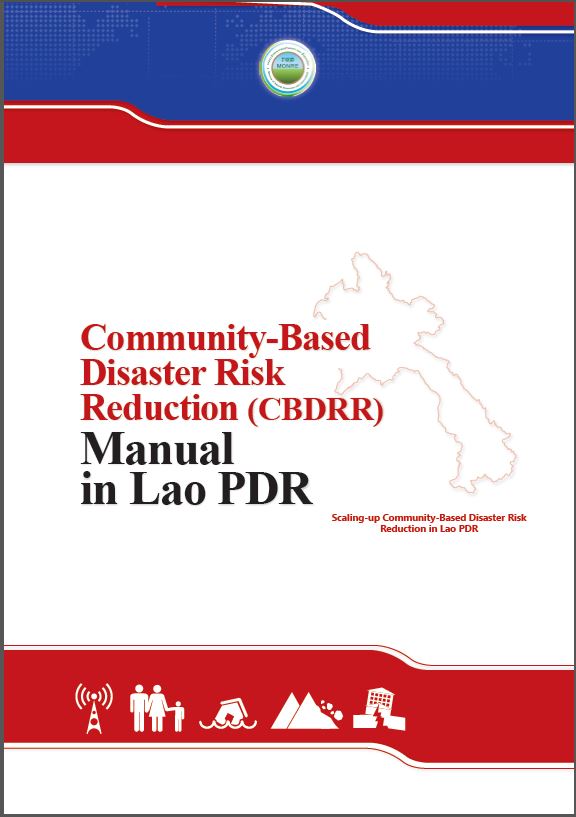Hyogo Framework for Action 2005-2015
The report is the extract from the final report of the World Conference on Disaster Reduction (A/CONF.206/6)
For more information, please refer to http://www.unisdr.org/2005/wcdr/wcdr-index.htm
![]()
Community-Based Disaster Risk Reduction (CBDRR) Manual in Lao PDR
Purpose:
The CBDRR Manual is a practical ‘how-to’ guide on community-based disaster risk reduction for government and non-government agencies in Lao PDR. It is a commonly agreed document to be referred to by agencies working on CBDRR in Lao PDR. It provides guidance and support for systematic implementation of CBDRR programs by explaining each of the steps as well as tools used.
The manual will also support the Government of Lao PDR (GoL) to monitor CBDRR activities, oversee progress of activities implemented by different actors and locations, provide necessary support on CBDRR technical knowledge as well as provide a reference point for replication of initiatives for local government and implementing agencies.
The manual was developed through a series of consultations with key stakeholders working on CBDRR in the country both from government and non-government agencies. Therefore, the CBDRR manual is based on
common activities implemented by different stakeholders in Lao PDR incorporating country regulations, government perspective and concerns.
Overview:
The CBDRR manual consists of:
Part I is an introductory part which gives background information about CBDRR in Lao PDR (including the importance of CBDRR in Lao PDR, the stakeholders of CBDRR in the country, as well as an overview about
the challenges and opportunities when implementing CBDRR in Lao PDR).
Part II contains the instructions on how to conduct the eight step process agreed upon by government and non government agencies working on CBDRR in Lao PDR. The 8 steps involved are:
Step 1: Pilot site selection
Step 2: Baseline study
Step 3: Capacity building for CBDRR facilitators
Step 4: Capacity building for VDPCC
Step 5: Community disaster risk assessment
Step 6: Participatory disaster risk management planning
Step 7: Community managed-implementation
Step 8: Participatory monitoring and evaluation
Usage: Guideline for implementation and monitoring
Target audience: National Society staff and volunteers
![]()
First aids and injury prevention in communities
Purpose: This document is aimed to raise understanding and awareness among volunteers and members of communities to understand about the Red Cross Movement, the role of Volunteers; understand concepts and techniques to deal with injuries and first aid cases; understand how to prevent accidents and injuries in communities.
Overview: The documents provides general knowledge, techniques to conduct first aids and injury prevention. It includes three parts:
- In the first chapter, the document gives a brief introduction about the Red Cross Movements, Vietnam Red Cross National Society and the roles and responsibility of volunteers
- First aids and accidents: Overview, popular accidents and techniques.
- Other injuries: scald, electric shock, drowning, insect or animal biting, poisoning.
Usage: Training, Guidance for implementation
Audience: Volunteers, Youth
![]()
Consolidation of Community Preparedness through Use of Games, Simulation Exercises and Information, Education and Communication (IEC) Materials
Purpose: The document is aimed to provide targeted major groups of audiences, namely community/households, students and teachers and disaster risk reduction practitioners, with various communication and public educational tools such as organizing awareness raising sessions, distribution of information, education and communication (IEC) materials and conducting of drills and simulation exercises in DRR and community preparedness programmes.
Overview: This case study looks into the approaches employed by Myanmar Red Cross Society (MRCS) Disaster management Division to improve the awareness of the target groups and draws out the enabling factors, challenges and lessons learned from the different activities. Main contents include:
-
Disaster Risk Reduction Education for Public
-
Raising Disaster Risk Reduction Awareness under On-going Risk Reduction Programs of MRCS
- Enabling Factors: four factors in terms of material availability, local language and local authority, community’s willingness
- Challenges: three challenges relating to materials, local authority’s validation of IEC tools, exclusion of illiterate members.
- Lessons Learned and Recommendations: five lessons and recommendations
Usage: Learning from experience
Audience: Technical staff, Volunteers
For Burmese version, click here Burmese, file size: 2 MB
![]()










